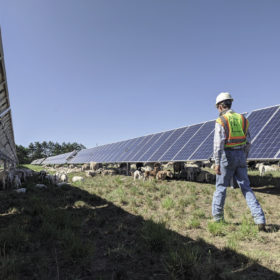Eyes in the sky
High-resolution satellite imagery has helped to identify most kinds of electricity infrastructure, including small-scale solar systems. Once the infrastructure has been identified, researchers can extract a range of insights, such as energy production estimates that allow for more efficient grid management, more accurate insurance assessments, and better targeting of potential customers.
The plan to REZurrect Australia’s large-scale segment
Investment in large-scale solar appears to be faltering in Australia. The technology with the lowest cost, with no emissions and the fastest time to delivery, has often found itself dangling at the oversubscribed end of a limp transmission line, with additional, expensive requirements to connect, or earnings-slashing curtailments when operational. Investors have found no reassurance in the federal government’s winking at coal, courting of gas, and undermining of agencies established to support innovation and investment in renewables. In short, the Australian prime minister is showing a complete lack of urgency to act on climate change. Enter the Renewable Energy Zone.
Vietnam’s most ambitious array
Could a single installation define a brief but explosive period of ambitious PV deployment? The massive 500 MW Dau Tieng solar array – among Southeast Asia’s largest PV installations – makes a strong case for being the most impressive project of Vietnam’s recent solar boom. But the allure of Dau Tieng is about much more than size – it’s about what’s beneath the PV modules.
Reaching for the rooftops
The solar industry is evolutionary, with costs and system efficiencies continually improving. Innovations like single axis trackers, storage, autonomous systems, bifacial modules, half-cut cells, reduced degradation, and multi MPPT inverters are helping to boost performance. Creative project owners and developers, meanwhile, continue to implement new ideas to maximize returns. This makes working as a technical solar PV consultant a fascinating prospect. With this in mind, Mathieu Labour, a partner at Everoze, reports about an exciting way to retrofit operational solar rooftop projects that was recently discovered in France.
Bulking up for bigger tracking challenges
Bigger modules and more challenging conditions are leading tracker designers to strengthen their offerings to deliver the stability required for long-term operation. Eduardo de San Nicolás, Soltec’s chief strategy officer, says that the Spanish company’s efforts have resulted in a new generation of trackers fit for almost any wind conditions – along with a host of other benefits including advanced communications and optimized bifacial yield.
The ground beneath
A number of drivers are highlighting the importance of vegetation management in utility-scale solar projects, from coupling with agriculture to the significance of pollinators, as well as the related permitting and O&M benefits. Tom Karas of Minnesota Native Landscapes sets out why awareness of comprehensive vegetation management is of growing importance in the solar sector.
Pioneering perovskite PV
At last month’s virtual EU PVSEC conference, Henry Snaith – a professor of physics at Oxford University – won the Becquerel Prize for his pioneering work on perovskite solar cells. As chief scientific officer at Oxford PV, Snaith is involved in planning the commercial launch of a perovskite-on-silicon tandem module for the middle of next year. pv magazine recently caught up with Snaith to discuss his prize-winning work and the current state-of-the-art in perovskite PV and tandem cells.
Limited risk of PV for landfill
While it’s far from ideal to have solar modules dumped in a landfill, in much of the world today, it’s a likely outcome. The silver lining to this dark cloud is that research published this year indicates that PV modules likely pose limited risks to human health, even using the most conservative assumptions. Garvin Heath, a senior scientist with the National Renewable Energy Laboratory (NREL) coordinated the study in his role as the Operating Agent of the International Energy Agency’s Technology Collaboration Programme on PV Power Systems (PVPS), Task 12 – Sustainability.
Circular innovations
Slowly but surely, environmental concerns are making their way into mainstream thought throughout the PV industry. A look at recycling offers an example of this, with stakeholders trying to get ahead of the high volumes of end-of-life modules already on the horizon. pv magazine examines the technologies that will be needed, alongside policy and economic support, to keep the bulk of these modules out of landfill and ultimately to establish a circular economy for PV materials.
Something truly new
You can try to succeed by making a better version of your competitors’ product, or you can try to do something completely new. NexWafe has chosen the second path. It is developing plans to manufacture wafers for high-efficiency solar cells in Bitterfeld, Germany, that are produced more sustainably and at lower cost than any other products available today.










